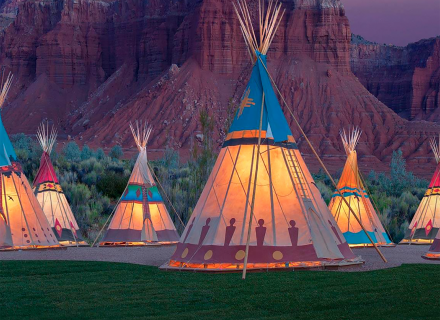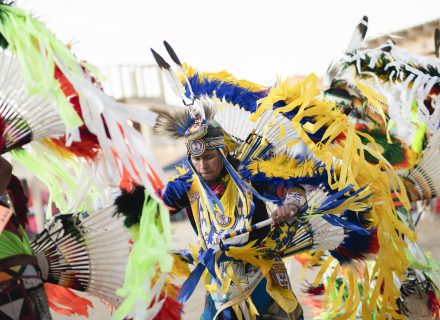Dale Claude Lamphere’s tribute to Native peoples also celebrates the beauty of the Great Plains.
She stands with her back to the wind and her face to the morning sun, and the diamonds in the star quilt she has wrapped around her shine like pieces of the night sky. She is Dignity of Earth and Sky, sculptor Dale Claude Lamphere’s celebration of Dakota and Lakota women and the Plains world they inhabit.
The 50-foot-tall sculpture of fabricated stainless steel stands just off Interstate 90 on the east bluff of the Missouri River near Chamberlain, South Dakota — the very heart of one of the two states named for the Dakota and Lakota people.
“A gentleman came to me and wanted to do something to acknowledge the Native nations we have here in South Dakota,” says Lamphere, who has a studio at the edge of the Black Hills near Sturgis, South Dakota. “He wanted it to be Native and a woman. Beyond that, there were no instructions.”
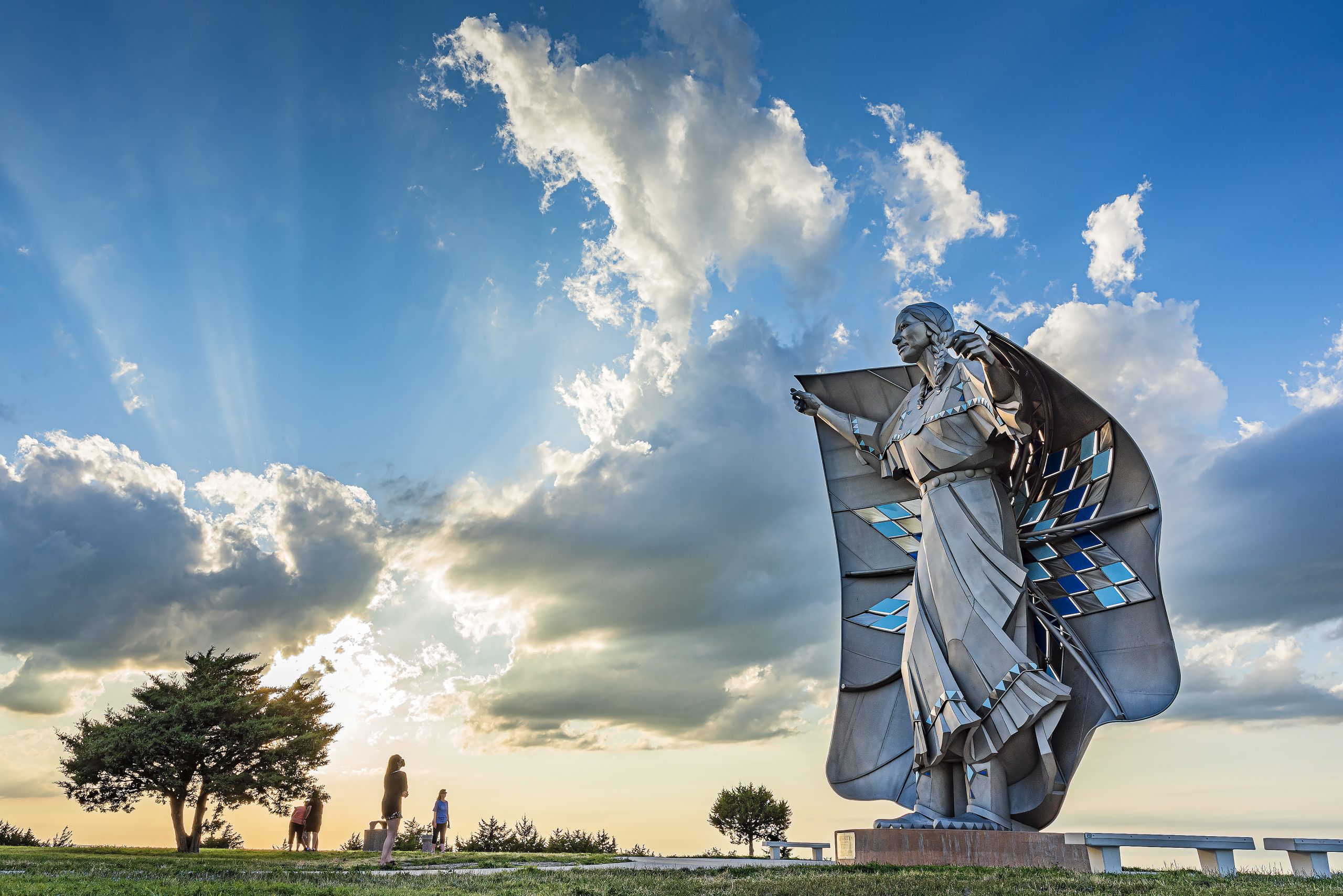 Dignity wears a garment patterned after a two-hide dress of the 1850s and holds an outstretched quilt with 128 stainless steel blue diamond shapes designed to flutter in the wind.
Dignity wears a garment patterned after a two-hide dress of the 1850s and holds an outstretched quilt with 128 stainless steel blue diamond shapes designed to flutter in the wind.
Lamphere, who is white, was hesitant. Appointed South Dakota Artist Laureate in 2015 (a post formerly held by the late great Dakota artist Oscar Howe), he has been criticized when he has occasionally done pieces that feature Native people.
Lakota artist Dwayne Wilcox, who is also a South Dakotan, says Lamphere is a talented artist, bar none. But, he says, creating monumental pieces on behalf of Native Americans seems to satisfy South Dakota’s need to acknowledge Native Americans while letting the mainstream culture handle the memory. “This is a hot topic in the South Dakota Native art world for the simple fact we don’t have that kind of skill or finance to sculpt such a large-scale project,” Wilcox says. “I don’t see a project of this magnitude ever being offered to us because of the financial burden it would bring to the artist.”
Lamphere acknowledges there’s a dilemma. “There’s a movement today, and rightly so, that Native artwork ought to be done by Native people,” he says. But then he thought about what could be done if he accepted the commission.
“As I began exploring the subject, I realized the design
possibilities of a star quilt were really exciting. A star quilt is a very important symbolic element in their culture. When a child is born, they wrap them in a star quilt, with the understanding that they have come down from the stars, and so the star quilt makes them feel more at home. And as they go on in life, whenever there’s a significant accomplishment, they give them a star quilt to honor that occasion.”
So he began to draw using the star quilt. “Then I contacted a Lakota friend of mine and wrapped her in a star quilt and went out on a windy day and began to design the sculpture.”
After five or six drawings, Lamphere moved on to a small clay maquette, and then eventually to a larger clay maquette. “It was 5 feet tall, and the ultimate work is 50 feet tall, so it made an easy translation.” The finished sculpture weighs 12 tons. It’s made of hundreds of pieces of stainless steel, including 128 diamonds for the quilt.
He ended up using three Native women for models: one in her 50s, one at the threshold of her 30s, and one a teenager. “I didn’t want to represent any one Native person but rather distill the essential characteristics and elements of their countenance and movement,” Lamphere says.
He also contemplated the location and placement. “I always consider the environment when working on these large-scale works,” he says. “In our Great Plains region, the prevailing wind is from the northwest, so I placed the back of the piece to that direction. I like to show as much interaction and integration with the environment as possible, so the dress is windswept, and the wind and sun can move through the piece. The diamonds are offset and there’s a slight bit of movement to them so it’s really part of the environment. As I came to consider what colors to use in the star quilt, I picked up the colors of the water and the sky that are immediately adjacent to the piece.”
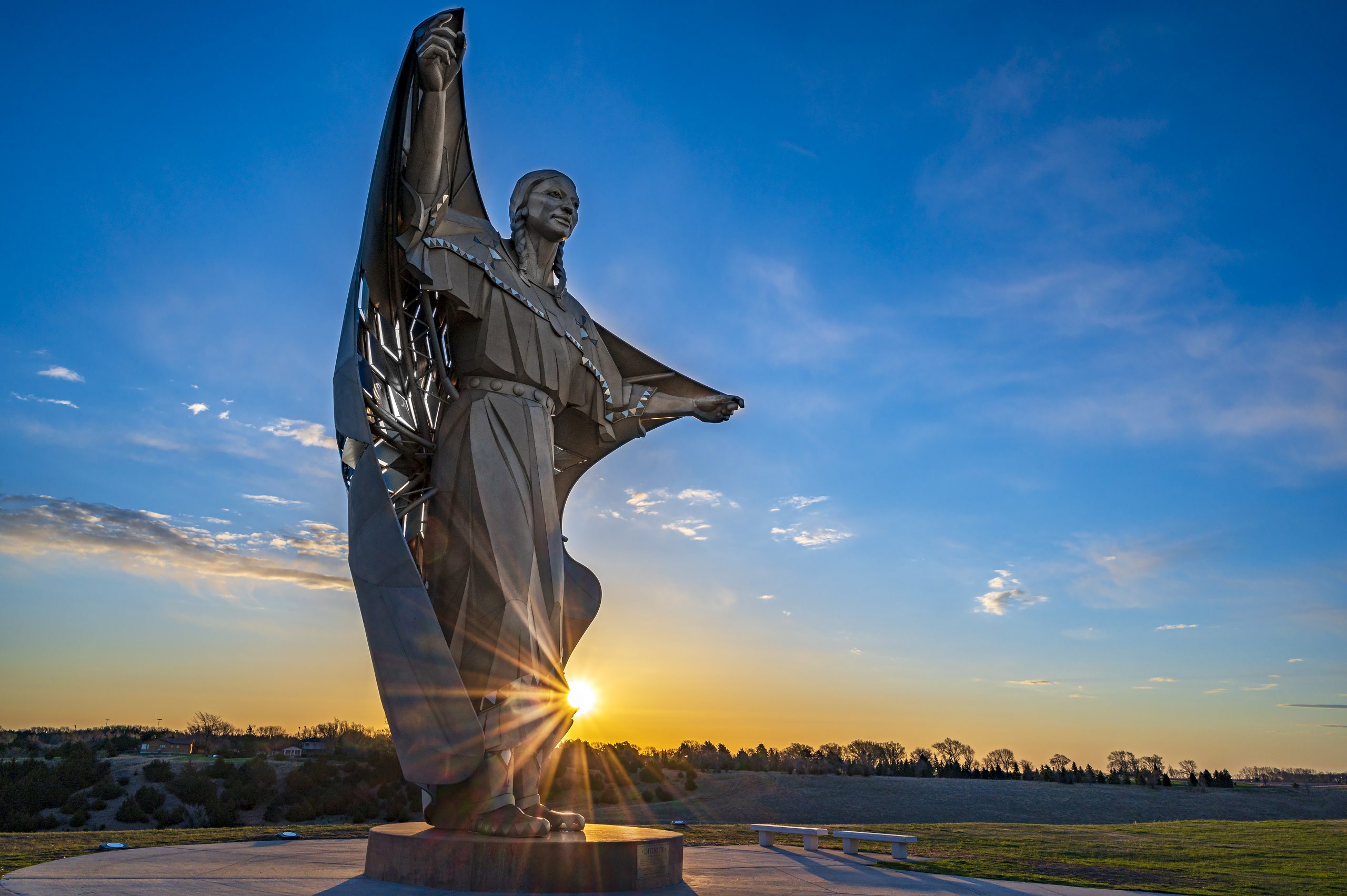 Honoring the Lakota and Dakota people, the 50-foot stainless steel statue Dignity stands on a bluff along I-90 near Chamberlain.
Honoring the Lakota and Dakota people, the 50-foot stainless steel statue Dignity stands on a bluff along I-90 near Chamberlain.
Lamphere suggests the name of the piece has a lot to do with the sweeping expanse of land and sky and the great river of the Plains that provide the context here on the east bluff of the Missouri.
“Initially, the working title was Of Earth and Sky. It was something rooted to the earth and yet of the waters, of the sky. But then the Dignity name was mentioned by the donor, and it stuck. It seems to me to speak more fully of the real wholeness and beauty of the Great Plains area. There is a dignity to the earth and the sky in this area that’s hard to miss.”
Lamphere, now 76, grew up in the ranch country of western South Dakota and has always paid attention to the land in his art. “The common element that runs through my work is the lyric line that I see in the mountain and prairie environment and the intersection of prairie to mountain, and the grasses, the flora of our Great Plains area. The wind is always blowing to some degree, so I study the movement of the grasses and the structure of them. These inform my work. Every piece is moving in some way, has a gesture to it, a sweep to it. Those are largely just echoing the environment in which I live.”
Work on Dignity of Earth and Sky began in 2014, and the piece was dedicated in September 2016. After a 53-year career making more than 60 large-scale pieces, life-size or bigger, Lamphere says Dignity has generated the greatest response by far.
“I’ve received more positive feedback on this sculpture than on any other work,” he says — and that includes an audience he’s particularly eager to please. “I’ve been fortunate that it’s been very well-received by Native communities. I’ve heard it referred to as ‘the Statue of Liberty for Native people.’”
Even visitors from other countries are taking note. Peter Zsolt Fekete, a native of Hungary who worked for a time as a researcher at South Dakota State University some years ago, saw the Dignity sculpture when he revisited the state in 2018.
“When we stopped, it was near to evening time,” Fekete says. “It was a late sunset, and the colors were amazing on this robe that she was wearing.”
Noting South Dakota’s history of conflict with Native Americans — it was the site of the infamous Wounded Knee Massacre of December 1890, for instance — Fekete says seeing Dignity was a positive surprise.
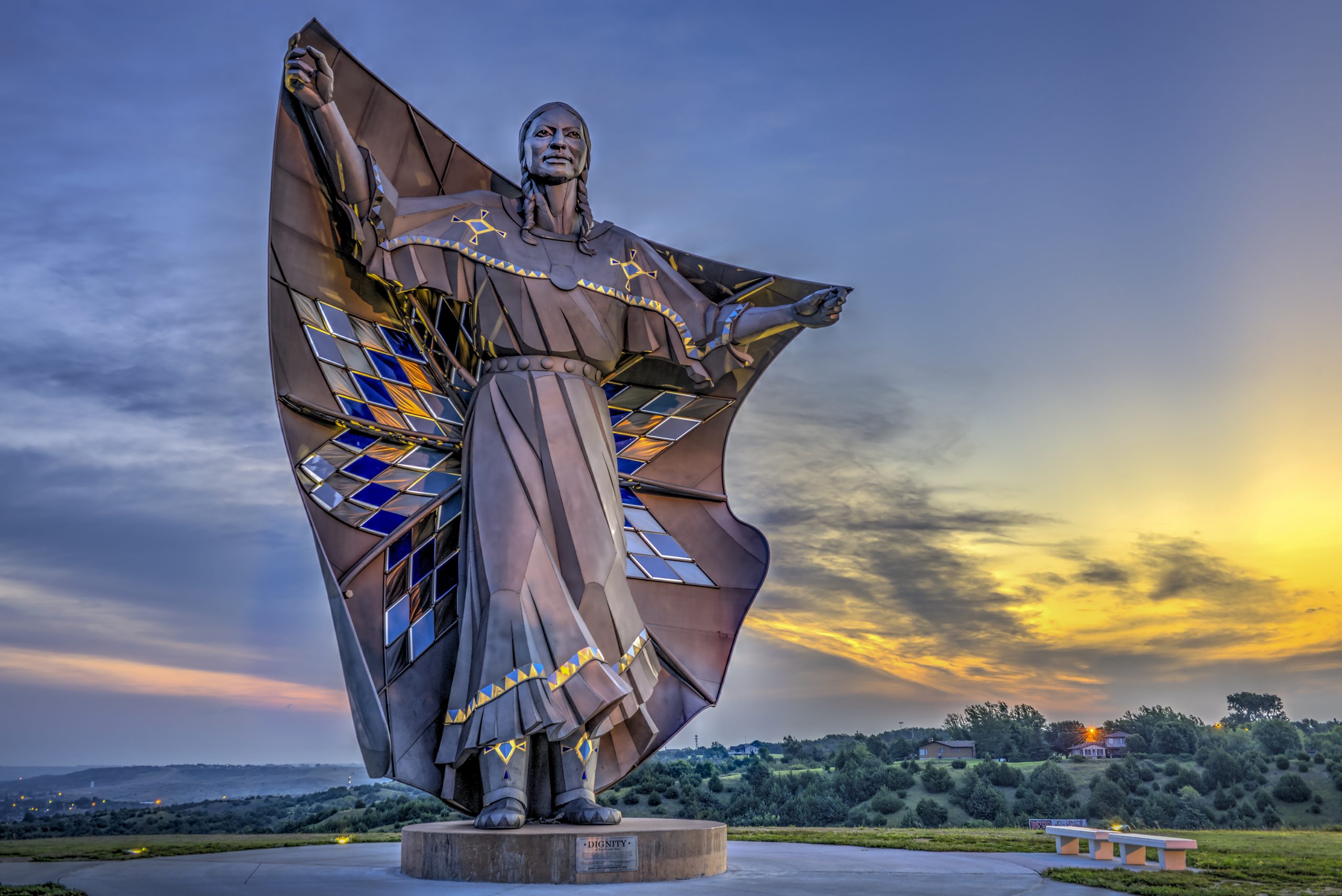 During the day, Dignity's star quilt — symbolizing respect, honor, and admiration in Native American culture — glitters in the sun. At night, LED lights cause the diamond shapes to glow.
During the day, Dignity's star quilt — symbolizing respect, honor, and admiration in Native American culture — glitters in the sun. At night, LED lights cause the diamond shapes to glow.
For Lamphere’s part, a non-Native artist can only try to grapple with the West’s history of conflict. “The kind of oppression that the Native communities have felt over the decades, it’s been a very difficult thing,” he says. “I don’t think we as white people really understand the generational trauma they’ve gone through. I tried to be empathetic to that.”
Katlyn Svendsen of Travel South Dakota says tourists and state residents alike have been struck by the elegance of the piece since it first took its place beside Interstate 90. “Certainly, since the installation, it has grown in popularity, and has become a notable icon for South Dakota,” Svendsen says.
As of July 2017, South Dakotans can even opt for a license plate design that features Dignity instead of the usual Mount Rushmore.
Though there are parts of the piece he might have liked to work on longer, Lamphere believes Dignity succeeded in ways that are not solely to do with the artist.
“In a sense I try to get out of the way. I try to be a human mechanism to make the sculpture manifest itself. If it’s a human form, I try to enter into the spirit of what I’m trying to create.” For Lamphere, the best creative activity is when the artist just becomes a conduit for something that needs to be said, something that wants to come out.
“My intent,” Lamphere says, “is for the sculpture to stand as an enduring symbol of our shared belief that all here are sacred and in a sacred place.”
This article appears in our February/March 2024 issue.
Visit Dale Lamphere online at lampherestudio.com.
See Dignity of Earth and Sky at the Chamberlain Interstate Welcome Center at mile post 264 (accessible by travel in both directions on I-90). See his Arc of Dreams spanning the Big Sioux River in downtown Sioux Falls.














